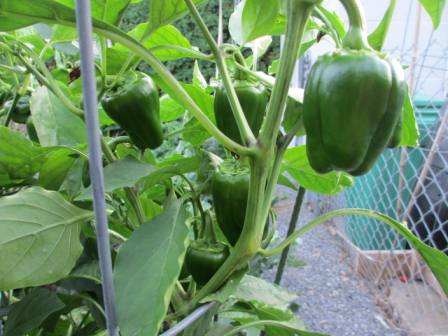Peppers Planting Instructions for NJ Zone 6
Peppers are a summer-loving plant here in NJ. The milder ones such as bell peppers lend a nice snap to summer salads as well as the soups and chilis of September. All peppers contain high amounts of vitamin C. Hotter varieties such as cayenne, jalapeno and habanero boast their own healing properties and are used to cure everything from the common cold to digestive troubles to lowering blood pressure.
How to plant:
Transplant pepper plants approximately 12-18″ apart in well-fertilized, raised garden beds. Try caging or staking as you would tomatoes; this will protect them from wind and give them their own space to avoid getting tangled up with other plants.
When plants grow to about 4″, thin the rows so that there is 4-6″ between. Once they reach 12″ high, mulch around the bottoms.
Spring planting time: May 15
Fall planting time: N/A
Seed depth: N/A (we recommend transplanting young pepper plants as opposed to growing from seed)
Plant spacing: 12-18″ apart
Plant height: 4-5 feet
Days to maturity: 60-70
Sun: full
Watering: moderate. Avoid saturating.
Best companions: Corn, bush beans, carrots, celery, cucumbers
Pests and disease:
Cutworms and tomato hornworms. Can be eliminated with an organic pesticide such as Bacillus thuringensis.
Harvesting:
Peppers will be one of the first plants to fall prey to the cooler temperatures of late summer. Here in NJ it will seem as though you’re waiting forever for your peppers to mature, and then suddenly all the plants are producing at once. Most people pick peppers when they turn green and appear full-sized. However, if you leave some on the plant they will continue to ripen and eventually turn red. As with eggplants and peas, the more peppers you pick, the more will blossom and grow. Your pepper plants will definitely not survive past the first frost of autumn, so be sure to harvest in a timely fashion.
Storage:
Store them on the countertop. For best flavor, pick and eat the same day. Can be packaged raw and frozen. Peppers are commonly pickled and jarred. You can also cook them in tomato salsa and can for use in the colder months. Hot pepper varieties can be dried by hanging the plant upside-down. Use latex gloves when handling hot peppers.
Other:
Over-fertilization of pepper plants produces lush foliage but not a lot of fruit. Also try to avoid touching the plants or picking peppers after a rain or a watering. This will spread viruses from your hands, which can damage plants.
The above content is reprinted from our 95-page, Complete Beginner’s Guide to Organic Gardening in NJ Zone 6.
To order your own, emailed electronic copy of this e-book by PayPal, simply click the link!
